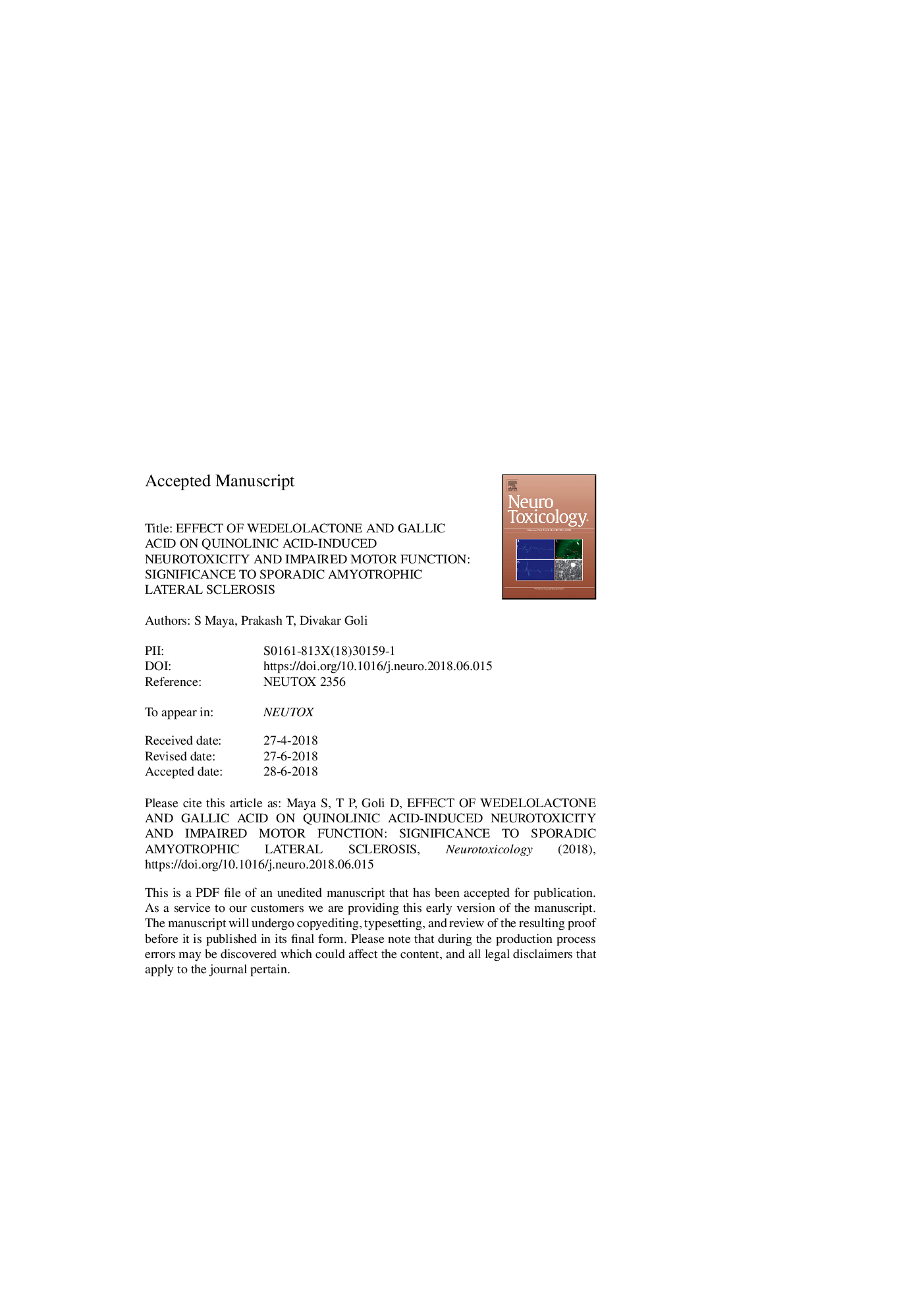| کد مقاله | کد نشریه | سال انتشار | مقاله انگلیسی | نسخه تمام متن |
|---|---|---|---|---|
| 8550034 | 1562026 | 2018 | 32 صفحه PDF | دانلود رایگان |
عنوان انگلیسی مقاله ISI
Effect of wedelolactone and gallic acid on quinolinic acid-induced neurotoxicity and impaired motor function: significance to sporadic amyotrophic lateral sclerosis
ترجمه فارسی عنوان
اثر برولولاکتون و گالیک اسید بر روی عصب نوکلئیک ناشی از اسید هیوینولینیک و اختلال عملکرد حرکتی: اهمیت به موارد منع گسترش اسکلروز جانبی آمیوتروفی
دانلود مقاله + سفارش ترجمه
دانلود مقاله ISI انگلیسی
رایگان برای ایرانیان
کلمات کلیدی
موضوعات مرتبط
علوم زیستی و بیوفناوری
علوم محیط زیست
بهداشت، سم شناسی و جهش زایی
چکیده انگلیسی
Quinolinic acid (QUIN) is a well-known neuroactive metabolite of tryptophan degradation pathway or kynurenine pathway. The QUIN is involved in the development of several toxic cascades which leads to the neuronal degeneration processes. The QUIN-induced toxicity is also responsible for the impairment of the motor function and motor learning ability. This study seeks to investigate the several mechanisms which are involved in the intrastriatal administration of QUIN-induced neurodegeneration and the neuroprotective effects of wedelolactone (WL) and gallic acid (GA) over QUIN-induced toxicity. The Wistar rats were used for the study and conducted behavioral model to evaluate the effects of WL (100 & 200â¯mg/kg) and GA (100 & 200â¯mg/kg) on impaired motor function and motor learning ability. We also assessed the effects of WL and GA on the antioxidant profile, cytotoxicity, apoptosis, excitotoxicity, inflammatory cascades, and on growth factors which helps in neurogenesis. The compounds effectively improved the motor function, motor learning memory in the rats. Similarly, enhanced the activity of Glutathione peroxidase, SOD, catalase, and declined the lipid peroxidation and nitrite production in the brain. The treatment with WL and GA lowered the activities of LDH, m-calpain, and caspase-3. The reports strongly support that both compounds are useful in the prevention of glutamate excitotoxicity induced by QUIN. The NAA, IGF-1, and VEGF levels in the brain were improved after treatment with WL and GA. The neuroprotective effects of WL and GA further proved through the anti-inflammatory effects. The compounds significantly down-regulated the expression of TNF-α, IL-6, and IL-β in the brain. Immunohistochemical analysis shows that the WL and GA reduced the expression of NF-κB. The histopathological studies for cerebellum, hippocampus, striatum, and spinal cord confirms the toxic effects of QUIN and neuroprotective effects of WL and GA. The results suggest that WL and GA could ameliorate the toxic events triggered by QUIN and might be effective in the prevention and progression of several cascades which lead to the development of sALS.
ناشر
Database: Elsevier - ScienceDirect (ساینس دایرکت)
Journal: NeuroToxicology - Volume 68, September 2018, Pages 1-12
Journal: NeuroToxicology - Volume 68, September 2018, Pages 1-12
نویسندگان
S Maya, Prakash T, Divakar Goli,
